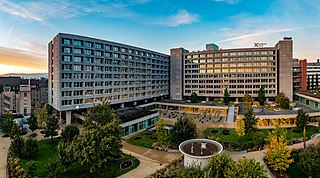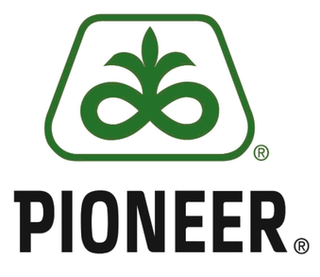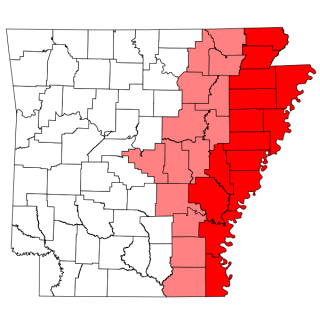The Monsanto Company was an American agrochemical and agricultural biotechnology corporation founded in 1901 and headquartered in Creve Coeur, Missouri. Monsanto's best known product is Roundup, a glyphosate-based herbicide, developed in the 1970s. Later, the company became a major producer of genetically engineered crops. In 2018, the company ranked 199th on the Fortune 500 of the largest United States corporations by revenue.
Roundup is the brand name of a systemic, broad-spectrum glyphosate-based herbicide originally produced by Monsanto, which Bayer acquired in 2018. Glyphosate is the most widely used herbicide in the United States. As of 2009, sales of Roundup herbicides still represented about 10 percent of Monsanto's revenue despite competition from Chinese producers of other glyphosate-based herbicides. The overall Roundup line of products, which includes genetically modified seeds, represented about half of Monsanto's yearly revenue. The product is marketed to consumers by Scotts Miracle-Gro Company.

Leland is a city in Washington County, Mississippi, United States. It is located within the Mississippi Delta, on the banks of Deer Creek. The population was 4,481 at the 2010 census. It was once a railway town and had long been a center of cotton culture, which is still an important commodity crop in the rural area. It was once considered the second-largest city in Washington County in 1920 due to its rapid growth of residents, businesses, and schools.

The Mississippi Delta, also known as the Yazoo–Mississippi Delta, or simply the Delta, is the distinctive northwest section of the U.S. state of Mississippi that lies between the Mississippi and Yazoo Rivers. The region has been called "The Most Southern Place on Earth", because of its unique racial, cultural, and economic history. It is 200 miles (320 km) long and 87 miles (140 km) across at its widest point, encompassing about 4,415,000 acres (17,870 km2), or, almost 7,000 square miles of alluvial floodplain. Originally covered in hardwood forest across the bottomlands, it was developed as one of the richest cotton-growing areas in the nation before the American Civil War (1861–1865). The region attracted many speculators who developed land along the riverfronts for cotton plantations; they became wealthy planters dependent on the labor of enslaved African Americans, who composed the vast majority of the population in these counties well before the Civil War, often twice the number of whites.

In agriculture and gardening, seed saving is the practice of saving seeds or other reproductive material from vegetables, grain, herbs, and flowers for use from year to year for annuals and nuts, tree fruits, and berries for perennials and trees. This is the traditional way farms and gardens were maintained for the last 12,000 years.
The Natchez District was one of two areas established in the Kingdom of Great Britain's West Florida colony during the 1770s – the other being the Tombigbee District. The first Anglo settlers in the district came primarily from other parts of British America. The district was recognized to be the area east of the Mississippi River from Bayou Sara in the south and Bayou Pierre in the north.

Genetically modified crops are plants used in agriculture, the DNA of which has been modified using genetic engineering methods. Plant genomes can be engineered by physical methods or by use of Agrobacterium for the delivery of sequences hosted in T-DNA binary vectors. In most cases, the aim is to introduce a new trait to the plant which does not occur naturally in the species. Examples in food crops include resistance to certain pests, diseases, environmental conditions, reduction of spoilage, resistance to chemical treatments, or improving the nutrient profile of the crop. Examples in non-food crops include production of pharmaceutical agents, biofuels, and other industrially useful goods, as well as for bioremediation.

Syngenta AG is a provider of agricultural science and technology, in particular seeds and pesticides with its management headquarters in Basel, Switzerland. It is owned by ChemChina, a Chinese state-owned enterprise.

Genetic use restriction technology (GURT), also known as terminator technology or suicide seeds, is the name given to proposed methods for restricting the use of genetically modified crops by activating some genes only in response to certain stimuli, especially to cause second generation seeds to be infertile. The development and application of GURTs is primarily an attempt by private sector agricultural breeders to increase the extent of protection on their innovations. The technology was originally developed under a cooperative research and development agreement between the Agricultural Research Service of the United States Department of Agriculture and Delta and Pine Land company in the 1990s and is not yet commercially available.

Pioneer Hi-Bred International, Inc. is a U.S.-based producer of seeds for agriculture. They are a major producer of genetically modified organisms (GMOs), including genetically modified crops with insect and herbicide resistance.

Dockery Plantation was a 25,600-acre (104 km2) cotton plantation and sawmill in Dockery, Mississippi, on the Sunflower River between Ruleville and Cleveland, Mississippi. It is widely regarded as the place where Delta blues music was born. Blues musicians resident at Dockery included Charley Patton, Robert Johnson and Howlin' Wolf. The property was added to the National Register of Historic Places in 2006.

The Arkansas Delta is one of the six natural regions of the state of Arkansas. Willard B. Gatewood Jr., author of The Arkansas Delta: Land of Paradox, says that rich cotton lands of the Arkansas Delta make that area "The Deepest of the Deep South."
Roundup Ready is the Monsanto trademark for its patented line of genetically modified crop seeds that are resistant to its glyphosate-based herbicide, Roundup.

SmartStax is a brand of genetically modified seed made through a collaboration between Monsanto Company and Dow Chemical Company. It takes advantage of multiple modes of insect protection and herbicide tolerance. SmartStax takes advantage of Yieldgard VT Triple (Monsanto), Herculex Xtra (Dow), RoundUp Ready 2 (Monsanto), and Liberty Link (Dow). The traits included protect against above-ground insects, below-ground insects, and provide broad herbicide tolerance. It is currently available for corn, but cotton, soybean, and specialty crop variations are to be released. Previously, the most genes artificially added to a single plant was three, but Smartstax includes eight. Smartstax also incorporates Monsanto's Acceleron Seed Treatment System which protects against insects at the earliest stages of development. Smartstax is sold under the Genuity (Monsanto) and Mycogen (Dow) brands.

Asgrow is a seed company owned and operated by Bayer Crop Science.
BASF Plant Science is a subsidiary of BASF in which all plant biotechnology activities are consolidated. The company was founded in 1998 and employs approximately 700 people at 6 different locations worldwide. The headquarters of BASF Plant Science is located in Research Triangle Park and has research sites in the US, Canada, and Europe. The company mainly develops genetically modified seeds at these locations.
Bowman v. Monsanto Co., 569 U.S. 278 (2013), was a United States Supreme Court patent decision in which the Court unanimously affirmed the decision of the Federal Circuit that the patent exhaustion doctrine does not permit a farmer to plant and grow saved, patented seeds without the patent owner's permission. The case arose after Vernon Hugh Bowman, an Indiana farmer, bought transgenic soybean crop seeds from a local grain elevator for his second crop of the season. Monsanto originally sold the seed from which these soybeans were grown to farmers under a limited use license that prohibited the farmer-buyer from using the seeds for more than a single season or from saving any seed produced from the crop for replanting. The farmers sold their soybean crops to the local grain elevator, from which Bowman then bought them. After Bowman replanted the crop seeds for his second harvest, Monsanto filed a lawsuit claiming that he infringed on their patents by replanting soybeans without a license. In response, Bowman argued that Monsanto's claims were barred under the doctrine of patent exhaustion, because all future generations of soybeans were embodied in the first generation that was originally sold.
Monsanto was involved in several high-profile lawsuits, as both plaintiff and defendant. It had been defendant in a number of lawsuits over health and environmental issues related to its products. Monsanto also made frequent use of the courts to defend its patents, particularly in the area of agricultural biotechnology.
Stine Seed Company is the world's largest private seed company, and the largest independent seed company in the US. It has more than 900 patents, specializing in soybean and corn genetics, is based in the small town of Adel, Iowa, and is almost entirely owned by Harry Stine and his four children.
J. E. M. Ag Supply, Inc. v. Pioneer Hi-Bred International, Inc., 534 U.S. 124 (2001), was a decision of the United States Supreme Court holding for the first time that utility patents may be issued for crops and other flowering plants under 35 U.S.C. § 101. The Supreme Court rejected the argument that the exclusive ways to protect these plants are under the Plant Variety Protection Act (PVPA), 7 U.S.C. § 2321, and the Plant Patent Act of 1930 (PPA), 35 U.S.C. §§ 161-164.











